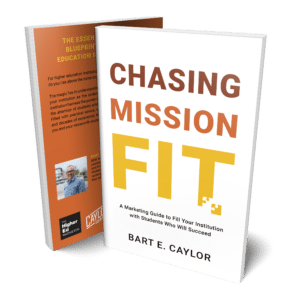Audience-Centric Marketing: Marketing in Service of Your Audience
Audience-centric marketing is a paradigm shift that can transform mediocre content into high performance marketing. Learn more!
Marketing Trends
Every technological revolution, such as generative AI tools, takes some time to be accepted by the greater population.
From the beginning of any new technology, early adopters jump on board and begin to experiment with how this innovation should be best applied for the benefit of everyone in the market.
They are the visionaries willing to take chances and deal with the bugs of the system as they are worked out along the way.
We’re seeing this same tech-adoption curve when it comes to generative AI tools in higher education.
In higher education, the adoption curve for new technologies or methodologies historically has a longer slope than for other industries.
But higher ed marketers can really lead the way in the application of generative AI tools for higher ed institutions!
 That’s what we’re seeing with several notable colleagues, like Dave Hunt, Director of Digital Marketing Communications and Creative Director at Old Dominion University.
That’s what we’re seeing with several notable colleagues, like Dave Hunt, Director of Digital Marketing Communications and Creative Director at Old Dominion University.
Several months before ChatGPT was released on November 30th, 2022, Dave was in the throes of developing a large-scale email marketing campaign at another university.
In the moment of ChatGPT’s release, Dave realized that the months of work that went into creating the campaign could all be done in minutes now.
This discovery led him into looking at how to use generative AI tools further to keep his new team at ODU doing the creative work instead of grunt work.
In this episode of The Higher Ed Marketer podcast, we talk with Dave about strategies to help leverage AI tools as a creative team.
At the beginning of our conversation, Dave Hunt emphasized the importance of fostering a culture of experimentation to overcome initial resistance to AI tools.
I just saw a stat this week that 92% of Fortune 500 companies are using OpenAI. There has been increasing adoption [of generative AI tools] in higher ed, but it’s such a huge opportunity to level playing fields in a lot of ways.
ChatGPT, and other AI tools are inexpensive and accessible, and so this is a revolution that’s not cost prohibitive for higher education to embrace.
The smaller your team and the fewer resources you have, the more important it might be for your organization to get on this bandwagon.
Within creative teams there should be a culture of experimentation. That should be a defining characteristic of a healthy creative team.
By transitioning workers from mundane tasks to more strategic roles, AI can be a game-changer.
There are considerations that are making some folks hesitant about [adopting the new technology].
AI can sometimes feel like it’s making what was [once] difficult work easy, and maybe there’s some undervaluing or some undercutting of creative work that’s happening there.
Then, of course, there is lots of fear about job displacement.
But with that, there’s lots of opportunity!
You can transition workers from being in roles where they’re having to do more mundane things to things that are more strategic and creative and complex work.
Dave highlights the significance of leadership in setting an open environment and leveraging team members who are enthusiastic about AI tools to evangelize their benefits.
There are things that you can do as a leader [to create] an environment where you’re open [to new ideas] and demonstrating that you’re also experimenting, creating, and trying and not necessarily always succeeding.
For every person who’s [more cautious about change], you usually have somebody like me who’s an early adopter, or somebody who’s at least more towards the middle of that adoption curve.
And so, [I recommend that you rely on] your team members [who are also early adopters], so it’s not always you doing the preaching, but finding others who are excited and willing to experiment, and then they can also help evangelize.
AI tools like ChatGPT and Adobe’s Firefly are revolutionizing creative workflows.
Dave reminisces about the days when isolating an image background required hours of meticulous work. Today, tools like Canva and Photoshop can accomplish this in seconds.
You see opportunity [with AI tools] for people to become more holistic with how they approach creative projects.
And not just, “It’s my job to sit here for 3 hours and do this mundane task to make something become real.”
Like, no, you can have the ideas, execute them, and keep ideating.
If you’re interested in exploring AI and technology, the sky’s the limit for what you could potentially learn and what you could do with that!
Generative AI allows creatives to stay at a higher level of creativity, focusing on ideation rather than execution.
By using AI to handle repetitive tasks, creative teams can explore new cross-disciplinary opportunities and push the boundaries of what’s possible.
Dave shares how his team uses AI to streamline project management and content creation.
Tools like monday.com now incorporate AI to automate standard project setups, saving time and reducing manual effort.
In content creation, AI acts as a partner, generating unique ideas and enhancing inspiration.
AI can also help you execute initial mockups quickly, allowing you to focus on strategic, on-brand final executions.
One of the most transformative aspects of AI in higher ed marketing is its ability to personalize student engagement for multiple audiences.
Dave recounts his “aha” moment with ChatGPT, where he realized AI could generate personalized email journeys, blog posts, and social media content.
I had come from a university where we were standing up really pretty substantial email journeys for new online programs.
We were doing like 30 email journeys that were designed to [cultivate prospective students from] the early prospect stage to enrollment. We wanted to have a bunch of communication we could send out.
[Previously], I had worked through all of that at a prior institution with an outside agency, seemingly by hand. I think that [the agency] was writing [all of this from scratch]. [That was] weeks of all this effort.
And then when I first started really playing with ChatGPT, I started realizing like this thing has memory.
[I also realized] I can put in a bunch of information about this [academic] program and it can spit a bunch of things out. I was asking it like, “Here’s a bunch of information on this program we’ve got, give me a blog post, give me social media posts, give me Personas, give me all this stuff.”
[At first, I did] not realize [that all that I was inputting into ChatGPT] was going into its memory.
Then I asked it just to see, “Could you create like a lengthy 15-email journey for me?”
At that moment, ChatGPT began generating a lightning-fast response with personas, emails, social media posts, and more for all of the many target audiences they were reaching out to.
That’s when it all clicked for Dave. As with the arrival of the Internet in the 90’s, this changes everything.
This one is focused on alumni, this one is focused on students, this one is focused on financial aid—with no prompts! My mind felt like it was literally exploding.
I leaned back in my desk and stared at the ceiling because this changes so much.
So many of us in higher ed are not resourced the way those Fortune 500 companies are. We don’t have a staff of dozens or, in some cases, hundreds.
For some of these large corporations [it has been possible] to be able to do this kind of personalization. But [now even small schools are] being able to now do these things with AI.
Of course, they need editing, curating, and reviewing. Don’t just spit something out that AI generates for you.
But how quickly you can give this system some information and have it do some of that personalization for you so that you can get more granular!
You don’t have to just settle for a dynamic field that just changes the program name. [With AI tools], you can go in and have this be truly specific for individual programs.
That was a huge moment for me, that realization.
This level of personalization was once out of reach for smaller institutions but is now accessible and scalable.
By using AI, higher ed marketers can create tailored content that resonates deeply with individual students, driving engagement and enrollment.
Our conversation with Dave sheds light on the transformative potential of AI tools in higher ed marketing.
By embracing AI, creative teams can enhance efficiency, drive innovation, and deliver highly personalized experiences to prospective students.
As AI technology continues to evolve, the opportunities for higher ed marketers to leverage these tools will only expand.
Did you know Caylor Solutions offers a 6-session AI Masterclass that will empower your team to maximize AI for creativity, productivity and time-management?
In these six sessions, you’ll gain actionable insights that can multiply the results you’re getting—and all without busting your budget!
And by the way, listen to our full interview with Dave Hunt to get even more insights into:
The essential marketing book every higher education institution needs! If you are a higher education marketing professional seeking a fail-safe plan to make your institution stand out, “Chasing Mission Fit” is your guide.
 Discover how to:
Discover how to:
So you can empower your institution with audience-focused marketing strategies, and attract mission-fit students who will flourish in your unique academic environment.
Ready to transform your institution’s marketing approach?
Order now!
Featured image via odu.edu
Subscribe to The Higher Ed Marketer podcast today!